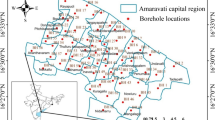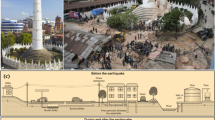Abstract
It is well known that the local soil condition is an important factor in changing the ground motion parameters during earthquake. Therefore, it becomes important to carry out site-specific earthquake risk study for the designing of earthquake-resistant structures due to future hazard. In the present study, a ground response analysis of a proposed bridge site over Barak River along Silchar Bypass Road is carried out to evaluate the local site effect with the real recorded earthquake ground motions available in this study area. Detailed soil investigation report in terms of SPT bore log profile is collected from the Government Agencies (Public Works Department, Govt. of Assam). In the absence of in situ shear wave velocity profile data, the Vs profiles are estimated from the known SPT-N value by proposing new empirical equations correlating Vs and SPT-N. After evaluation of the Vs 30 profiles, the site is then classified according to the provisions of National Earthquake Hazards Reduction Program (NEHRP). The input ground motions used for the analyses are in the form of acceleration time histories obtained from two recorded earthquakes such as Ms 7.2 (India–Burma Border earthquake, 1988) and Mw 6.4 (India–Burma Border earthquake, 1995). The modulus reduction and damping ratio curves are obtained from the different research works published considering the characteristics of subsurface profiles. The ground response analyses have resulted in the calculation of the ground motion parameters as well as the amplification factor, and response spectra at the ground surface for the site. The results have revealed that the ground motion at bed rock level has been highly amplified by the soil layers at three different frequency ranges from 2 to 8 Hz for both the earthquakes with a maximum amplification factor up to 4.6. The average surface level peak ground acceleration for the bridge site is found to be 0.25 and 0.18 g for the Ms = 7.2 and Mw = 6.4 earthquakes, respectively. Further, the averaged response spectrum of both the earthquakes for the bridge site is compared with the response spectrum of the Indian Standard (IS) 1893:2002. The design response spectrum for the bridge site is also developed considering NEHRP provisions. Therefore, the results would be very much useful for the designer, planner and the Govt. of Assam for the safety of such important bridge for earthquake-resistant design to mitigate seismic hazard.














Similar content being viewed by others
References
Anbazhagan P, Kumar A, Sitharam TG (2012) Seismic site classification and correlation between standard penetration test N value and shear wave velocity for Lucknow City. Indo-Gangetic Basin. Pure Appl Geophys 170(2013):299–318
Athanasopoulos GA (1995) Empirical correlations Vs-NSPT for soils of Greece: a comparative study of reliability. In: ASC Akmak (ed), Proceedings of the 7th international conference on soil dynamics and earthquake engineering (Chania, Crete) (Southampton: Computational Mechanics), pp 19–36
BIS 1893 (2002) Indian standard criteria for earthquake resistant design of structures, part-1 general provisions and buildings. Bureau of Indian Standards, New Delhi
Chien LK, Lin MC, Oh YN (2000) Shear wave velocity and SPT-N values of in situ reclaimed soil in west Taiwan. Geotech Eng J Southeast Asian Geotech Eng Soc 31:63–77
Dikmen U (2009) Statistical correlations of shear wave velocity and penetration resistance for soils. J Geophys Eng 6(1):61–72
Fujiwara T (1972) Estimation of ground movements in actual destructive earthquakes. In: Proceedings of the 4th European symposium earthquake engineering (London), pp 125–32
Fumal TE, Tinsley JC (1985) Mapping shear wave velocities of near surface geological materials. In: Ziony TI (ed), Predicting areal limits of earthquake induced landsliding; In evaluation of earthquake hazards in the Los Angeles region—an earth science perspective. USGS paper 1360, pp 127–150
Hanumantharao C, Ramana GV (2008) Dynamic soil properties for microzonation of Delhi, India. J Earth Syst Sci 117(S2):719–730
Hasancebi N, Ulusay R (2006) Empirical correlations between shear wave velocity and penetration resistance for ground shaking assessments. Bull Eng Geol Environ 66:203–213
Idriss IM, Sun J (1991) User’s manual for SHAKE91. Center for Geotechnical Modeling, Department of Civil and Environmental Engineering, University of California
Imai T (1977) P-and S-wave velocities of the ground in Japan. In: Proceedings of the 9th international conference on soil mechanics and foundation engineering, vol 2, pp 127–132
Imai T, Fumoto H, Yokota K (1975) The relation of mechanical properties of soil to P- and S- wave velocities in Japan. In: Proceedings of 4th Japan earthquake engineering sympossium. pp 89–96 (in Japanese)
Imai T, Tonouchi K (1982) Correlation of N-value with S-wave velocity and shear modulus. In: Proceedings of the 2nd European symposium of penetration testing (Amsterdam), pp 57–72
Imai T, Yoshimura Y (1970) Elastic wave velocity and soil properties in soft soil. Tsuchito-Kiso 18(1):17–22 (in Japanese)
Iyisan R (1996) Correlations between shear wave velocity and in-situ penetration test results. Digest 96:371–374
Jafari MK, Asghari A, Rahmani I (1997) Empirical correlation between shear wave velocity (Vs) and SPT-N value for south of Tehran soils. In: Proceedings of the 4th international conference on civil engineering, Tehran, Iran (in Persian)
Jafari MK, Shafiee A, Razmkhah A (2002) Dynamic properties of fine grained soils in south of Tehran. J Seismol Earthq Eng 4:25–35
Japan Road Association (1980) Specification for highway bridges, part IV, Seismic design. Japan Road Association, Tokyo (in Japanese)
Jinan Z (1987) Correlation between seismic wave velocity and the number of blow of SPT and depth. Chin J Geotech Eng (ASCE), 92–100 (selected papers)
Kalteziotis N, Sabatakakis N, Vassiliou J (1992) Evaluation of dynamic characteristics of Greek soil formations. In: Second hellenic conference on geotechnical engineering, vol 2, pp 239–246 (in Greek)
Kanai K (1966) Conference on cone penetrometer. The Ministry of Public Works and Settlement, Ankara, Turkey (presented by Y Sakai 1968)
Kayabali K (1996) Soil liquefaction evaluation using shear wave velocity. Eng Geol 44(1):121–127
Kayal JR (1996) Earthquake source process in North East India: a review. Him Geol 17:53–69
Kayal JR (1998) Seismicity of Northeast India and surroundings—development over the past 100 years. J Geophys 19(1):9–34
Kiku H, Yoshida N, Yasuda S, Irisawa T, Nakazawa H, Shimizu Y, Ansal A, Erkan A (2001) In-situ penetration tests and soil profiling in Adapazari, Turkey. In: Proceedings of the ICSMGE/TC4 satellite conference on lessons learned from recent strong earthquakes, pp. 259–265
Lee CT, Tsai BR (2008) Mapping Vs30 in Taiwan. Terr Atmos Ocean Sci 19(6):671–682
Lee SHH (1990) Analysis of the multicollinearity of regression equations of shear wave velocities. Soils Found 32(1):205–214
Molnar P, Taponnier P (1975) Cenozoic tectonics of Asia, Effects of continental collision. Science 189:419–426
Ohba S, Toriumi I (1970) Dynamic response characteristics of Osaka Plain. In: Proceedings of the annual meeting, A. I. J (in Japanese)
Ohsaki Y, Iwasaki R (1973) On dynamic shear moduli and Poisson’s ratio of soil deposits. Soil Found 13:61–73
Ohta T, Hara A, Niwa M, Sakano T (1972) Elastic shear moduli as estimated from N-value. In: Proceedings of the 7th annual convention of Japan society of soil mechanics and foundation engineering, pp 265–268
Ohta Y, Goto N (1978) Empirical shear wave velocity equations in terms of characteristic soil indexes. Earthq Eng Struct Dyn 6:167–187
Okamoto T, Kokusho T, Yoshida Y, Kusuonoki K (1989) Comparison of surface versus subsurface wave source for P–S logging in sand layer In: Proceedings of the 44th annual conference on JSCE, vol 3, pp 996–997 (in Japanese)
Pitilakis KD, Anastasiadis A, Raptakis D (1992) Field and laboratory determination of dynamic properties of natural soil deposits. In: Proceedings of 10th world conference on earthquake engineering, Rotherdam, pp 1275–1280
Pitilakis K, Raptakis D, Lontzetidis KT, Vassilikou T, Jongmans D (1999) Geotechnical and geophysical description of Euro Seistests, using field and laboratory tests, and moderate strong ground motions. J Earthq Eng 3:381–409
Raptakis DG, Anastasiadis SAJ, Pitilakis KD, Lontzetidis KS (1995) Shear wave velocities and damping of Greek natural soils. In: Proceedings of 10th European conference on earthquake engineering, Vienna, pp 477–482
Rosset P, Puente ADI, Chouinard L, Mitchell D, Adams J (1991) Site effects assessment at small scales in urban areas a tool for preparedness and mitigation. In: 4th international conference on seismic zonation, Standford, California, 25–29 August, 1991
Sarmah SK (1999) The probability of occurrence of a high magnitude earthquake in Northeast India. J Geophys 20(3):129–135
Schnabel PB, Lysmer J, Seed HB (1972) SHAKE: a computer program for earthquake response analysis of horizontally layered sites. Report No. UCB/EERC-72/12, Earthquake Engineering Research Center, University of California, Berkeley, p 102
Seed HB, Idriss IM (1970) Soil moduli and damping factors for dynamic response analysis. Report No. UCB/EERC-70/10, Earthquake Engineering Research Center, University of California, Berkeley, December
Seed HB, Idriss IM (1981) Evaluation of liquefaction potential sand deposits based on observation of performance in previous earthquakes. In: ASCE national convention (MO), pp 81–544
Seed HB, Idriss IM, Arango I (1983) Evaluation of liquefaction potential using field performance data. J Geotech Eng ASCE 109:458–482
Seed RB, Dickenson SE, Riemer MF, Bray JD, Sitar N, Mitchell JK, Idriss IM, Kayen RE, Kropp A, Harder LF, Power MS (1990) Preliminary report on the principle geotechnical aspects of the October 17, 1989 Loma Prieta Earthquake. Report No. UCB/EERC-90/05, Earthquake Engineering Research Center, University o f California, Berkeley
Shibata T (1970) Analysis of liquefaction of saturated sand during cyclic loading. Disaster Prevent Res Inst Bull 13:563–570
Sisman H (1995) The relation between seismic wave velocities and SPT, pressure meter tests. M.Sc. thesis Ankara University (in Turkish)
Sitharam TG, Anbazhagan P (2008) Seismic Microzonation: principles, practices and experiments. Electron J Geotech Eng Spec Vol Bouquet 08:1–61
Sil A, Sitharam TG (2014) Dynamic site characterization and correlation of shear wave velocity with SPT ‘N’ values for the city of Agartala, Tripura state, India. J Pure Appl Geophys. https://doi.org/10.1007/s00024-013-0754-y
Sykora DE, Stokoe KH (1983) Correlations of in situ measurements in sands of shear wave velocity. Soil Dyn Earthq Eng 20:125–136
Sil Arjun, Haloi J (2017) Empirical correlations with standard penetration test (SPT)-N for estimating shear wave velocity applicable to any region. Int J Geosynth Ground Eng 3(3):22
Tonouchi K, Sakayama T, Imai T (1983) S wave velocity in the ground and the damping factor. Bull Int Assoc Eng Geol 26–27:327–333
Tsiambaos G, Sabatakakis N (2011) Empirical estimation of shear wave velocity from in situ tests on soil formations in Greece. Bull Eng Geol Environ 70:291–297
Uma Maheswari R, Boominathan A, Dodagoudar GR (2010) Use of surface waves in statistical correlations of shear wave velocity and penetration resistance of Chennai soils. Geotech Geol Eng 28(2):119–137
Vucetic M, Dobry R (1991) Effect of soil plasticity on cyclic response. J Geotech Eng Div ASCE 111(1):89–107
Wood HO (1908) Distribution of apparent intensity of San Francisco in the California earthquake of April 18, 1906. Carnegie Institution Publication, Washington D.C, pp 220–245
Yokota K, Imai T, Konno M (1991) Dynamic deformation characteristics of soils determined by laboratory tests. OYO Tee Rep 3:13
Acknowledgements
This work was supported by Institute Grant Number PA/254/18890
Author information
Authors and Affiliations
Corresponding author
Rights and permissions
About this article
Cite this article
Sil, A., Haloi, J. Site-specific ground response analysis of a proposed bridge site over Barak River along Silchar Bypass Road, India. Innov. Infrastruct. Solut. 3, 63 (2018). https://doi.org/10.1007/s41062-018-0167-y
Received:
Accepted:
Published:
DOI: https://doi.org/10.1007/s41062-018-0167-y




